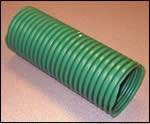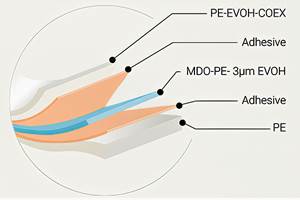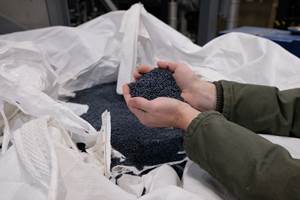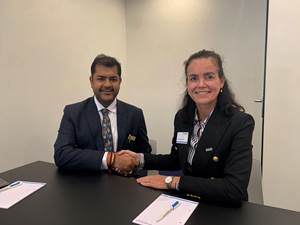Recycled PET/PE Alloys Show Promise In Monofilament, Pallets, Pipe
Alloys of polyethylene and recycled PET were the highlight of the annual SPE Global Plastics Environmental Conference (GPEC) in Detroit in February.
Alloys of polyethylene and recycled PET were the highlight of the annual SPE Global Plastics Environmental Conference (GPEC) in Detroit in February. In the last 18 months, three European processors have commercialized products made of these novel blends, which are said to be stiff, tough, easy to process, and inexpensive. These are believed to be the first commercial uses of PET/PE blends, though experiments with such combinations have been reported in the technical literature for decades. The existence of commercial products made from such alloys was made public for the first time at GPEC 2004 by Erema North America, which has worked with all three European processors. They all use Erema’s Vacurema continuous solid-stating drum to heat and dry the PET under high vacuum and restore its I.V.
One of the three is a Spanish injection molder that uses industrial scrap from five- and seven-layer barrier packaging film (containing PET, EVA, and LDPE) plus PET bottle flake to extrude monofilament for brush bristles. The second is a Belgian molder of shipping containers, which makes pallets out of PET with some HDPE blended in. The third is a U.K. recycler and maker of HDPE drainage pipe, which just qualified dual-wall corrugated pipe for highway drainage made of a similar PET/HDPE alloy. The pipe is expected to be in production within 12 months.
Alloying PET and PE doesn’t make economic sense if you start with virgin PET, but it pays off as a use for inexpensive waste streams like colored PET and barrier PET film scrap that normally find only low-value applications or are thrown away.
Combining PET and PE can yield unusual properties. The alloys are less brittle than PET and no longer need to be dried before processing. They’re stiffer, better flowing, and faster cooling than HDPE, so they mold and extrude with faster cycles and higher outputs. They also can be downgauged relative to straight HDPE.
Other machinery besides Erema’s solid-stater could be used to make the alloys—such as a crystallizing dryer followed by a vented twin-screw extruder modified with a long L/D. The key consideration is how much of virgin PET’s properties must be retained for the intended end product. The initial uses in pipe, bristles, and pallets all need high strength and wear resistance.
Erema says it isn’t seeking patents on the alloying process because it believes that too much is known about it through prior technical publications. But that may not rule out potential application patents. The Belgian processor, for example, has applied for patents on use of its material for pallets.
Pioneering applications
Injection molder Spalex S.A., now merged with Sp. Berner Plastic Group SL in Aldaya (Valencia), Spain, takes five- and seven-layer barrier film scrap from blown film processors and alloys the material in an extruder with PET bottle flake, then extrudes the mix into monofilament for brush bristles. The bristles are said to perform comparably to nylon, but cost much less.
The coex film scrap contains enough EVA tie layer to compatibilize the PET and LDPE. Spalex began producing monofilament and molding brushes three years ago using one Vacurema continuous solid-stating and extrusion line. It has since added a second Erema line.
Innova Packaging System N.V. (I.P.S.) in Ieper, Belgium, has alloyed green PET and PE for about six months. It compression molds this blend into gray and black shipping pallets. I.P.S. combines about 75% green PET bottle flake with about 25% recycled HDPE plus a substantial amount of unnamed compatibilizer. The result is said to come close to achieving plastic pallet makers’ long-sought goal of cost-competitiveness with wood. I.P.S.’s PET/PE pallets sell for 6 to 8 Euros ($7.50 to $8.50) apiece vs. about 5 Euros ($6.50) for a wooden pallet.
I.P.S. bought its first PET/PE alloying and molding line from Remaplan Anlagenbau in Landau, Germany, just before Remaplan went out of business last year. The alloying and molding process developed by Remaplan started with a crystallizing dryer, followed by an Erema Vacurema unit and then an extruder. The PET is at about 392 F as it comes out of the solid-stater and goes into the extruder. Relatively little heat is added in the extruder to reach PET’s processing temperature of about 450 F. PE and the compatibilizer are added in the extruder, which continuously pumps the melt into an injector that feeds compression molds.
Similar machinery is now being built by former Remaplan employees who joined MBM Maschinenbau in Germany. MBM has shipped similar pallet molding lines to Japan. Delleve Plastics Ltd. in Stratford-on-Avon, U.K., worked for three years to qualify dual-wall corrugated pipe made of an alloy of PET and HDPE plus a compatibilizer and an impact modifier. Delleve was bought this year by JFC Manufacturing Ltd.,which will produce the pipe at a new plant in Team, Ireland.
Delleve operates its own HDPE recycling plants in the U.K. Up to now, it used the PE in corrugated dual-wall drainage pipe and sold the PET flake to others. The alloying technology will enable it to use all the recyclate internally.
The PET/PE alloy exceeds the British Board of Agrément’s HAPAS (Highway Authority Product Approval Scheme) standard for HDPE highway drainage pipe. In fact, the PET/PE pipe “outperformed HDPE and PVC pipe by up to five times,” says Erema’s v.p. of sales, Michael Horrocks.
Delleve says single-wall PET/PE pipe of 75-mm diam. showed average initial stiffness of 5.678 kN/m2. “This is as good as our 100-mm HDPE pipe and is certainly over the 2-kN/m2 pass limit for this type of pipe,” Delleve reports. This would allow the PET/PE pipe to be downgauged and still exceed the required properties. The alloy flows so well and cools so fast that the corrugators don’t need vacuum.
Erema has had the alloy tested in the U.K. for injection molding. It reportedly molds without predrying, resulting in high properties and cycle times half as long as for HDPE.
Ties that bind
PET and PE need help to stick together. A variety of compatibilizers—some patented—satisfy this need. EVA is the typical tie layer binding PET to PE in coex films and is also used to alloy condensation polymers to PE. It’s less expensive than other commercial compatibilizers but more may be needed—as much as 5% to 10% by weight.
Erema found that using a two-stage Vacurema system with vacuum on the initial crystallizing dryer allows use of less compatibilizer than with Vacurema alone. It took up to 5% of a functionalized ethylene copolymer to compatibilize PET and PE with just the Vacurema device. But use of the two-stage vacuum system dropped the additive requirement to 0.3% to 0.6%.
Related Content
Recycling Terminology Can Be a Minefield, So We Should Tread Lightly
Loose propagation of terms like “recyclable” and “compostable” has already brought down government regulations on labeling. The plastics and packaging industries should take that to heart with other recycle-related language. Like “monomaterial” for example.
Read MoreFoam-Core Multilayer Blow Molding: How It’s Done
Learn here how to take advantage of new lightweighting and recycle utilization opportunities in consumer packaging, thanks to a collaboration of leaders in microcellular foaming and multilayer head design.
Read MoreNew Facility Refreshes Post-Consumer PP by Washing Out Additives, Contaminants
PureCycle prepares to scale up its novel solvent recycling approach as new facility nears completion.
Read MoreJoint Venture Will Build Largest Mechanical Recycling Plant in India
Lyondell Basell and Shakti Plastic Agreed to Build and Operate Plant to Process PCR
Read MoreRead Next
Understanding Melting in Single-Screw Extruders
You can better visualize the melting process by “flipping” the observation point so that the barrel appears to be turning clockwise around a stationary screw.
Read MoreTroubleshooting Screw and Barrel Wear in Extrusion
Extruder screws and barrels will wear over time. If you are seeing a reduction in specific rate and higher discharge temperatures, wear is the likely culprit.
Read MorePeople 4.0 – How to Get Buy-In from Your Staff for Industry 4.0 Systems
Implementing a production monitoring system as the foundation of a ‘smart factory’ is about integrating people with new technology as much as it is about integrating machines and computers. Here are tips from a company that has gone through the process.
Read More













.png;maxWidth=300;quality=90)


















